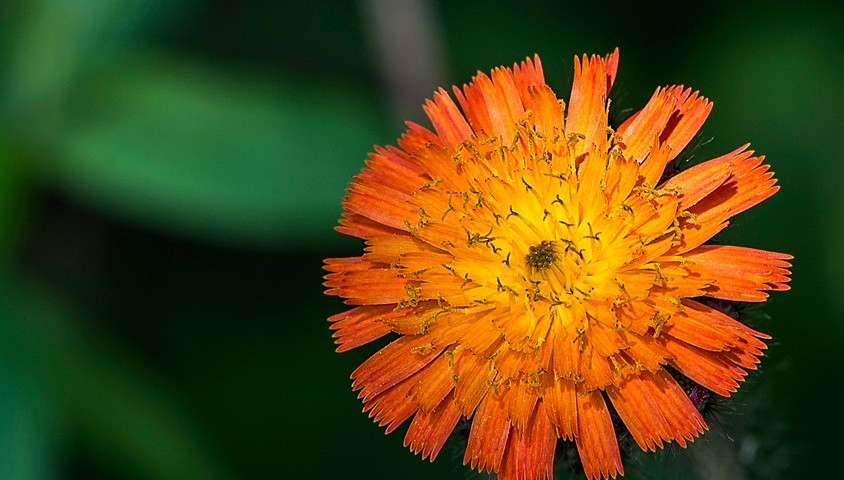Bushwalkers manage to cover a lot of ground throughout Australia, some of which is in inaccessible, remote or trackless country. This can be advantageous in unintended ways.
Bushwalkers can be a valuable source of information if they report noxious weed sightings to their local parks agency.
Weeds are best defined simply as plants growing in the wrong place. They are problematic in the natural environment when they outcompete native plant species, which may lead to a decrease in food or habitat resources for native fauna. Invasion by exotic plants into natural ecosystems is acknowledged to be the second largest threat to biodiversity, second only to habitat loss. Weeds may impact the landscape by altering light conditions or hydrology. Some weeds even have toxic compounds that affect native plants or animals. Noxious weeds are weedy plant species that are controlled and or managed under state or territory legislation.
A Recent Addition: Orange Hawkweed
A recent plant-based threat for our alpine conservation has arrived in the form of hawkweed (of which there are many species) in our alpine areas. In particular, orange hawkweed is a new weed that has the potential to become widely established and to threaten native biodiversity.
Orange hawkweed originates from Europe and was introduced to the Falls Creek alpine resort as a garden plant in the early 1990s but quickly spread into adjoining bushland, including the Alpine National Park. Subsequently, new populations have been detected at Mount Buller and also around Mount Jagungal in Koscuiszko National Park. How they got there is unknown, but spread by bushwalkers cannot be discounted (so in this case, bushwalkers may actually be the cause of the problem, and this re-iterates the importance of cleaning camping equipment and not entering infested areas). This progress towards the species’ establishment in Australia’s key alpine region has led orange hawkweed to become listed as noxious in both Victoria and New South Wales, but it has also been identified as a threat to Tasmania as well, should a population find its way there.

Signs like this one warn visitors to avoid certain areas in Falls Creek in a bid to mitigate further spreading.
Hawkweeds are successful invaders because they can tolerate a large range of growing conditions, and can produce many seeds that are spread by wind, animals and vehicles. They form mat-like colonies and their roots can secrete toxic chemicals to prevent competition from other plants. In the South Island of New Zealand, the mouse-ear hawkweed has displaced extensive areas of alpine tussock grasslands.
Control of hawkweed species is currently managed by hand spraying and this is often achieved by fencing affected areas and monitoring before and after treatment to ensure that plants are successfully treated and do not re-grow. Signs are deployed around Falls Creek to ensure that no one enters the area to prevent spreading the plant and to report other sightings.
Weeds: A Matter of Contain and Control
Annually, many millions of dollars are spent on weed control in Australia, but this could be reduced if problem exotic species are detected and controlled early. Early detection and intervention has been very successful in preventing the establishment of new weeds and is likely to prevent degradation of landscapes more effectively than the control of well-established populations of weeds.
In order to maximise cost-efficiency, control efforts need to focus on new source populations, while they are still small and isolated. Recognising the potential of new, introduced plants or even new strains of plants (e.g. pasture species) is also key in preventing invasions into natural environments.

An illustration of the noxious orange hawkweed (Hieracium aurantiacum). Image: Wikimedia Commons.
Some weeds may require a change in the environment in order to spread. For example, a bushfire will create bare ground that can be easily colonised by exotic species. Hence, vigilance in observing the landscape and monitoring changes in the years after a fire (or other natural disturbance) are important. Global warming may cause environmental impacts such as rising sea levels, increased droughts or severe weather events, which in turn could change natural habitats and ecosystems. These changes may benefit the establishment of weeds and highlight the need to recognise the potential threat of an exotic species before the population expands and the control is insurmountable.
Bushwalkers can help the control of weeds by reporting new and unusual plants sighted, as these may be weeds. Granted, not everyone has botanical knowledge nor do they know what to look for. For this reason, it is worth checking whether the area in which you plan to walk has any noxious weeds that could be reported and looked out for during the walk. Different states will have different species listed as noxious weeds and ways to report them, and it is prudent to check these before setting off on a bushwalk.
Click the below links to see information on noxious weeds for each state:
- Victoria
- New South Wales
- Australian Capital Territory
- South Australia
- Western Australia
- Northern Territory
- Tasmania
Bushwalkers can also help by cleaning their equipment and taking care not to spread weeds. Many plants have seeds with hooks or spines that can adhere to clothing, gaiters, packs – anything with velcro attracts plants seeds. Refraining from entering areas that contain weeds is also important in controlling the spread of weeds, and these areas are sometimes signposted.
The orange hawkweed is only one example in only one environment. The keen eye of the bushwalker can assist in finding small isolated populations of noxious weeds before they spread and become uncontrollable.


